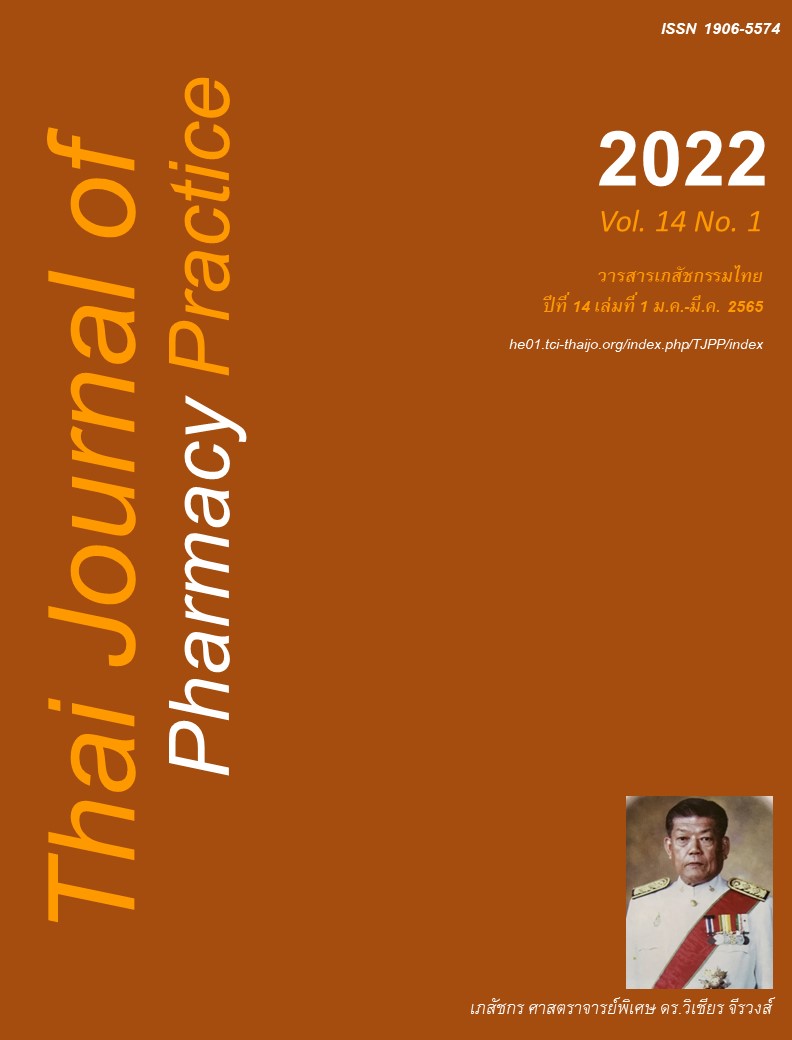ความรอบรู้ด้านผลิตภัณฑ์สุขภาพและความสัมพันธ์ต่อพฤติกรรมการบริโภค ผลิตภัณฑ์สุขภาพที่ถูกต้องของประชาชนในเขตคลองสามวา กรุงเทพมหานคร
Main Article Content
บทคัดย่อ
วัตถุประสงค์: เพื่อประเมินความรอบรู้ด้านผลิตภัณฑ์สุขภาพของประชาชนในเขตคลองสามวา กรุงเทพมหานคร และความสัมพันธ์ต่อพฤติกรรมการบริโภคผลิตภัณฑ์สุขภาพที่ถูกต้อง วิธีการ : การวิจัยเชิงภาคตัดขวางแบบวิเคราะห์สุ่มตัวอย่างแบบสะดวก จำนวน 400 คน ครอบคลุมพื้นที่ 5 แขวงของเขตคลองสามวา กรุงเทพมหานคร การศึกษาใช้แบบสอบถามเก็บข้อมูลส่วนบุคคล ความรอบรู้ด้านผลิตภัณฑ์สุขภาพ และพฤติกรรมการบริโภคผลิตภัณฑ์สุขภาพที่ถูกต้อง ระหว่างวันที่ 15 มกราคม พ.ศ. 2563-30 เมษายน พ.ศ. 2563 การวิเคราะห์ความสัมพันธ์ของทั้งสองตัวแปรใช้ multivariable logistic regression ผลการวิจัย: กลุ่มตัวอย่างส่วนใหญ่เป็นเพศหญิง (ร้อยละ 62.5) อายุเฉลี่ยเท่ากับ 33±11.14 มากกว่าครึ่งหนึ่งอยู่ในช่วง 20-39 ปี (ร้อยละ 53.2) รายได้ส่วนใหญ่อยู่ในช่วง มากกว่า 10,000 ถึง 15,000 บาท (ร้อยละ 43.8) รายได้ไม่เพียงพอร้อยละ 25.0 ผลิตภัณฑ์สุขภาพที่ใช้เป็นประจำได้แก่ อาหาร ยา เครื่องสำอาง (ร้อยละ 63.5, 50.2 และ 44.0 ตามลำดับ) ร้อยละ 7.5 เคยได้รับอันตรายจากการใช้ผลิตภัณฑ์สุขภาพ เมื่อวิเคราะห์ความสัมพันธ์ของความรอบรู้ด้านผลิตภัณฑ์สุขภาพทั้ง 6 ด้านกับพฤติกรรมการบริโภคผลิตภัณฑ์สุขภาพอย่างถูกต้องโดยควบคุมอิทธิพลของปัจจัยส่วนบุคคล พบความสัมพันธ์อย่างมีนัยสำคัญทางสถิติของความรอบรู้ 4 ด้าน ได้แก่ ความรู้ความเข้าใจระดับสูงเกี่ยวกับผลิตภัณฑ์สุขภาพ (Adj. OR 10.90, 95%CI: 1.96-60.68) การจัดการตนเองเกี่ยวกับผลิตภัณฑ์สุขภาพ (Adj. OR 4.84 ; 95%CI: 2.40-9.76) การรู้เท่าทันสื่อและสารสนเทศเกี่ยวกับผลิตภัณฑ์สุขภาพ (Adj. OR 3.35; 95%CI: 1.16-9.66) และการตัดสินใจเลือกผลิตภัณฑ์สุขภาพ (Adj. OR 6.02; 95%CI: 2.84-12.79) สรุป: จากความสัมพันธ์เชิงบวกที่พบระหว่างความรอบรู้ด้านผลิตภัณฑ์สุขภาพ 4 ด้านและพฤติกรรมการบริโภคผลิตภัณฑ์สุขภาพที่ถูกต้อง ควรมีการพัฒนาความรอบรู้ด้านผลิตภัณฑ์สุขภาพเพื่อช่วยเพิ่มพฤติกรรมที่ถูกต้องให้กับประชาชน โดยอาจส่งผลในการเพิ่มความปลอดภัย และเป็นข้อมูลในการพัฒนาระบบเฝ้าระวังพฤติกรรมการบริโภคผลิตภัณฑ์สุขภาพได้อย่างตรงจุดมากยิ่งขึ้น
Article Details
ผลการวิจัยและความคิดเห็นที่ปรากฏในบทความถือเป็นความคิดเห็นและอยู่ในความรับผิดชอบของผู้นิพนธ์ มิใช่ความเห็นหรือความรับผิดชอบของกองบรรณาธิการ หรือคณะเภสัชศาสตร์ มหาวิทยาลัยสงขลานครินทร์ ทั้งนี้ไม่รวมความผิดพลาดอันเกิดจากการพิมพ์ บทความที่ได้รับการเผยแพร่โดยวารสารเภสัชกรรมไทยถือเป็นสิทธิ์ของวารสารฯ
References
Prachatai. Consumer situation in Q2/2019--the most prevalent problem is still advertising exaggeration [online]. 2019 [cited May 25, 2021]. Available from: www.prachatai.com/journal/2019/08/83702.
Thai PBS News. 5 years, scarifying 10 lives for “diet pills” [online]. 2018 [cited May 25, 2021]. Available from: www.news.thaipbs.or.th/content/271945.
Division of Health Education, Department of Health Service Support Ministry of Public Health. Enhan- cing and assessing health literacy and health behavior children and youth groups (7-14 years old), people 15 years and older (revised edition 2018) [online]. 2019 [cited Feb 1, 2021]. Available from: www.hed.go.th/linked/file/575.
Kerdsri K, Lerkiatbundit S. Relationship between health literacy and self-protection ability among consumers in health products. Thai Journal of Pharmacy Practice 2018; 10: 240-8.
Chobthamasakul S. Relationship between health literacy and obesity prevention behavior of undergraduate students in Bangkok metropolitan region. Journal of Interdisciplinary Research: Graduate Studies 2019; 8: 116-23.
Chantha W. Health literacy of self-care behaviors for blood glucose level control in patients with type 2 diabetes, Chainat province. [master thesis]. Bang- kok: Thammasat University; 2016.
Administrative Strategy Division, Bangkok metropolitan. Bangkok statistics for the year 2019 [online]. 2019 [cited May 3, 2021]. Available from: www.bangkok.go.th/pipd/page/sub/16647.
Institute for Population Research. A research projects on factors affecting behavioral modification of health products consumption of today’s consumers [online]. 2015 [cited May 3, 2021]. Available from: www.db.oryor.com/databank/upload s/fda/0723178001471420204_file.pdf.
Bujang MA, Sa'at N, Sidik TMITAB, Joo LC. Sample size guidelines for logistic regression from observa- tional studies with large population: emphasis on the accuracy between statistics and parameters based on real life clinical data. Malays J Med Sci 2018; 25: 122–30.
Marketeer. Online shopping 2020 grows on unusual situations [online]. 2020 [cited May 3, 2021]. Available from: www.marketeeronline.co/arc hives/165701.
Consumer Potential Development Division, Food and Drug Administration, Ministry of Public Health. A full report of surveying knowledge and consumption behavior of public health products in the target communities of the 25th project, operating provinces under the united community network project prevent threats, health products, fiscal year 2019 [online]. 2019 [cited May 3, 2021]. Available from: www.db.oryor.com/databank/upload s/fda/0498965001574655290_file.pdf.
Lertwut L. Factors related to behavior in health products purchasing and consuming of people in Chachoengsao Province, 2015. FDA Journal 2015; 22: 12-21.
Wilcock A, Pun M, Khanona J, Aung M, Consumer attitudes, knowledge, and behavior: a review of food safety issues. Trends Food Sci Technol 2004; 15: 56-66.
Daechasilpchaikul B. A study of knowledge level, health products purchasing and consumption behavior of population, Srisaket province in 2007. FDA Journal 2008; 22: 25-31.
Li N, Zhang P. Consumer online shopping attitudes and behavior: an assessment of research. Eighth American Conference on Information Systems [online]. 2002 [cited May 3, 2021]. Available from: www.researchgate.net/publication/2557074.
Authamontree S. Effectiveness of experiential health education instruction model to promote media literacy regarding health products on internet of high school students. Humanities Journal 2012; 19: 163-76.
Yenjabok, P. Decryption of ideas for media literacy: A guide to learning, know the media. Bangkok: Offset Creation; 2009.

